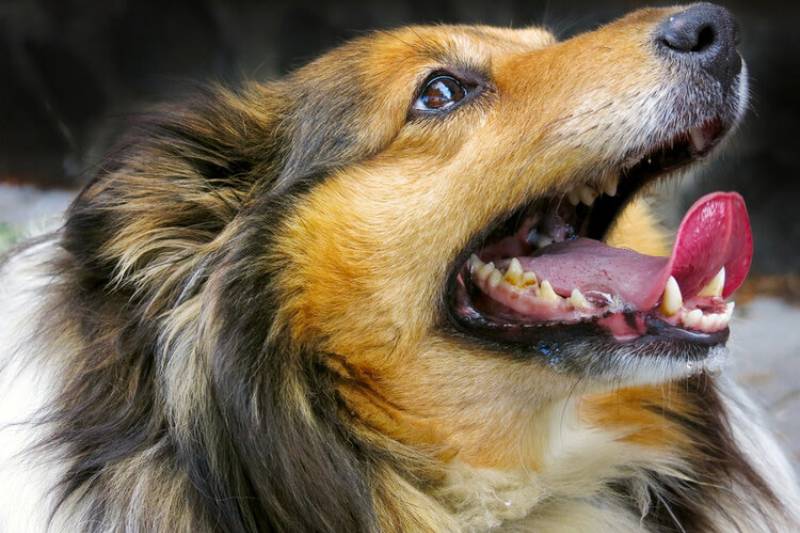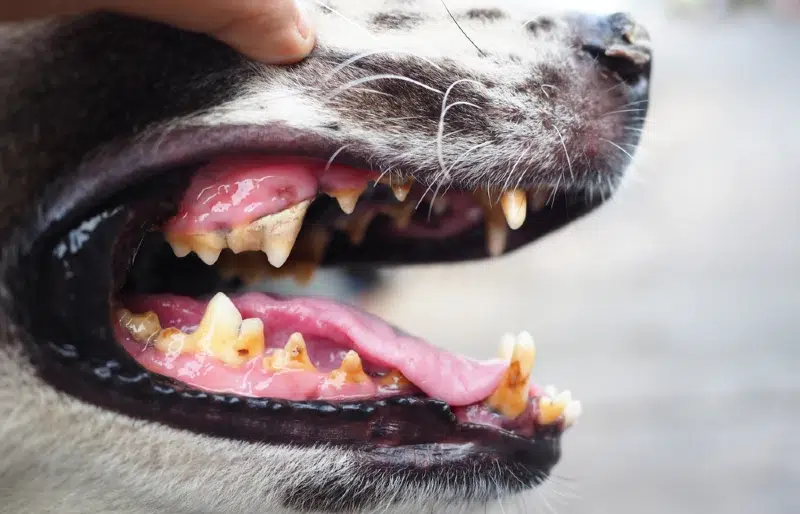It is probably not hard to recall the last time you brushed your teeth, but how about your pup’s pearly whites? Dental disease is incredibly common, affecting more than 80% of adult dogs1. However, cavities are pretty rare. The dogs’ diet, oral bacteria, saliva pH, and the shape and spacing of their teeth are different from ours.
However, it is crucial to help our canine friends maintain good oral health. Keep reading to learn more about cavities in dogs and how to keep their teeth in great shape.

What Are Cavities?
Cavities are areas of tooth decay. Human and veterinary dentists refer to cavities as “caries” (which means “rot” or “decay” in Latin).
- Pit and fissure cavities
- Smooth surface cavities
- Root cavities
Dr. Fraser Hale (a Canadian veterinary dental specialist) reports that pit and fissure cavities are most common in dogs. They usually originate from the chewing surfaces of the first upper molars.
- Stage 1: Enamel only
- Stage 2: Enamel and dentin
- Stage 3: Enamel, dentin, and pulp
- Stage 4: Enamel, dentin, and pulp with crown damage
- Stage 5: Enamel, dentin, and pulp with most of the crown missing and exposed roots
The stage of a cavity determines how it is treated.

What Are the Signs of Cavities in Dogs?
In many cases, dogs may not show any signs of having cavities, especially if they are in an early stage. Mild decay affecting only the enamel is unlikely to be painful and may only be visible as a small area of discoloration.
We mentioned that most canine cavities occur in the upper molars, which are located at the back of their mouth. It isn’t an area most pet parents look at regularly! Dog cavities are uncommon to be found in their early stages unless identified during a Comprehensive Oral Health Assessment and Treatment (COHAT).
A cavity extending through the enamel into the dentin, pulp, or root can cause pain and infection. Dogs are very good at hiding their discomfort and often continue to eat, even if their mouths hurt.
- Chewing primarily on one side of the mouth
- Dropping food when chewing
- Decreased appetite or drinking
- Increased drooling
- Halitosis (bad breath)
- Avoiding being touched near their mouth or face
What Causes Cavities in Dogs?
- Bacteria in the mouth ferment carbohydrates and release acids.
- The acids demineralize tooth enamel (the hard outer surface), allowing bacteria and enzymes to gain access to the dentin layer underneath.
- Tiny holes form in the dentin layer and get larger and larger until the enamel collapses because it is no longer supported.
- Decay progresses deeper into the tooth until it eventually reaches the pulp, causing pain and making the tooth susceptible to infection.
- Their diet is lower in sugar and fermentable carbohydrates.
- They have different bacteria in their mouth.
- Their saliva is more alkaline, which helps neutralize acids produced by oral bacteria.
- Their teeth tend to be spaced further apart, meaning fewer spots for food to sit and lots of room for saliva to move between the teeth.
- Most of their teeth have a pointy shape, so food doesn’t tend to sit on them.
Pups that eat sugary treats and have crowded teeth may be at higher risk of developing cavities.


How Are Cavities Diagnosed in Dogs?
As we have discussed, dogs’ cavities tend to occur in the upper molars, making them very difficult to see in an awake patient. Most are diagnosed during a Comprehensive Oral Health Assessment and Treatment (COHAT).
- Professional cleaning and polishing
- Probing the teeth and under the gumline to look for any hidden problems
- Full-mouth dental radiographs (X-rays)
- Any treatment that may be required (e.g., extraction of unhealthy teeth)
Cavities can look like dark spots or discolored areas on the surface of an affected tooth, which are soft or sticky when probed. Some are only visible on dental radiographs. Severe cavities may be immediately apparent if a large part of the tooth has been destroyed.
How Do I Care for a Dog With Cavities?
If you suspect your pup may have cavities or any other type of dental disease, it is crucial to seek veterinary treatment sooner rather than later. It is not possible to treat cavities at home, and if they are not addressed, they will get worse over time.
Your veterinarian will recommend a COHAT to look for cavities and other types of dental disease. If your pup requires restorative treatments (e.g., fillings, root canals) to try and save compromised teeth, you may be referred to a veterinary dental specialist.
Teeth affected by severe cavities are often not treatable and require extraction. Many pet parents are concerned that their pup might struggle to eat after having teeth removed, but in most cases, once their mouth has healed from surgery, they can eat just fine!

How Can I Protect My Pup Against Cavities?
Even though they are not common in dogs, there are a few things you can do to help reduce your pup’s risk of developing cavities:
- Avoid feeding sugary treats
- Brush their teeth regularly (daily, if possible!)
Make sure only to use pet-specific toothpaste that does not contain fluoride or xylitol!
Here are some tips for making brushing a positive experience for you and your pup:
- Ideally, start brushing your dog’s teeth when they are a puppy so it will be a well-established habit by the time they reach adulthood
- Start slowly and keep each experience positive; it’s okay if your pup licks toothpaste off your finger the first few times!
- Try a few types of toothbrushes to see what works best for you and your pup
If you find brushing too challenging, ask your veterinarian if dental chews or a prescription dental diet might be a good alternative.

Frequently Asked Questions (FAQ)
How Common Are Cavities in Dogs?
Cavities are rare in dogs. Dr. Fraser Hale, a Canadian board-certified veterinary dentist, reviewed 435 cases treated at his referral practice and found that only 5.3% of the dogs had one or more cavities.
Are Certain Breeds More Likely to Be Affected By Cavities?
Dr. Hale noted that cavities appeared more commonly in large-breed dogs, like German Shepherds and Labrador Retrievers.

Are Cavities Painful for Dogs?
Early cavities affecting only the outer surface of the enamel are unlikely to bother your pup, but decay extending further into the tooth can be painful.
Dogs are very good at hiding their discomfort from us. They continue eating despite dental pain, so we should never assume everything is fine because their appetite is normal.
What Happens if Cavities Are Not Treated?
If cavities are not treated, they will get worse over time. Once they have reached the inner structures of an affected tooth, they can cause pain and infection.
Final Thoughts
While cavities do not occur frequently in dogs, dental disease is very common. It is vital to take good care of your pup’s teeth, just as you care for your own!
Don’t forget to schedule regular check-ups with your veterinarian so they can monitor your pup’s oral health. If problems arise, early intervention can provide more options for treatment.
Featured Image Credit: Kasang.Foto, Shutterstock











